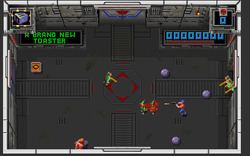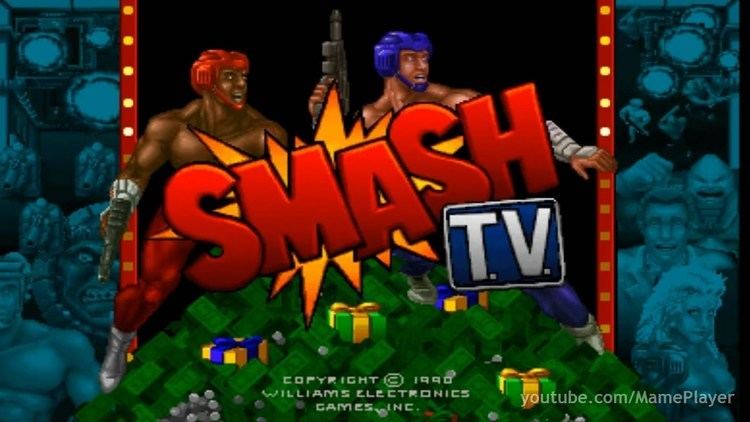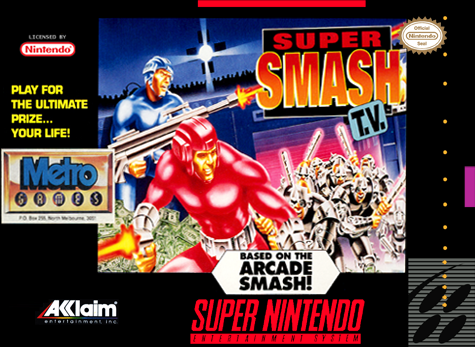Programmer(s) Mark Turmell Composer(s) Jon Hey Initial release date April 1990 | Artist(s) John TobiasTim Coman Cabinet Upright | |
Genre(s) Multidirectional shooter Mode(s) Single-playerTwo player co-op Developers WMS Industries, Krome Studios Melbourne, Williams Entertainment Inc., Acclaim Cheltenham Publishers Midway Games, WMS Industries, Acclaim Entertainment, ASCII Corporation, Ocean Software, Flying Edge Similar WMS Industries games, Shoot 'em up games | ||
Smash tv ps1 playthrough nintendocomplete
Smash TV is a 1990 arcade game created by Eugene Jarvis and Mark Turmell for Williams. It is a dual-stick shooter in the same vein as its predecessor, Robotron: 2084 (also produced by Jarvis). As in the previous game, players battle waves of enemies by using guns. The plot of Smash TV revolves around a futuristic game show in which players compete for various prizes as well as their lives.
Contents
- Smash tv ps1 playthrough nintendocomplete
- Smash tv arcade williams 1990 720p
- Gameplay
- Development
- Ports
- References
The Super NES, Genesis, Master System, and Game Gear versions were titled Super Smash TV.
The 1992 Williams arcade game Total Carnage shares many elements with Smash TV, and was also programmed by Turmell, but isn't a sequel.

Smash tv arcade williams 1990 720p
Gameplay

The play mechanic is similar to that of Eugene Jarvis' earlier Robotron: 2084, with dual-joystick controls and series of single-screen areas. The theme of the game, borrowed from The Running Man, involves players competing in a violent game show, set in the then-future year of 1999. Moving from one room to the next within the studio/arena, players have to shoot down hordes of enemies who advance from all sides while at the same time collecting weapons, power-up items, and assorted bonus prizes, until a final showdown with the show's host where players are finally granted their prizes, life and freedom. Among the game's items are keys – if enough keys are collected, players can access a bonus level called the Pleasure Dome.
The game features verbal interjections from the gameshow host such as "Total Carnage! I love it!", "dude!" and "I'd buy that for a dollar!". The former quote gives itself to the title of the 1991 follow-up, Total Carnage, which, while not a direct sequel, features similar gameplay. The quote "I'd buy that for a dollar!" is a reference to the catchphrase of Bixby Snyder, a fictional television comic in the 1987 film RoboCop.
Development

Mark Turmell recounted, "When Hasbro pulled the plug on an interactive movie project I was working on, I went to Williams to design coin-op games. I moved to Chicago, hired John Tobias, and together we did our first coin-op, Smash T.V."

The announcer in the game is voiced by sound designer Paul Heitsch. The script was created by the game's sole composer and sound designer Jon Hey.
Originally the arcade game shipped without the Pleasure Dome bonus level implemented, although there was text mentioning it in the game. The design team had not been sure that players would actually get to the end of the game. However, players did finish the game and after arcade operators informed Williams of player complaints of being unable to finish it, the company sent out a new revision that included the Pleasure Dome level.
In an interview first made available on Arcade Party Pak, Eugene Jarvis and Mark Turmell both agreed that a Smash TV sequel had been contemplated.
Ports
Smash TV was ported to consoles, including the Nintendo Entertainment System, Super NES, Game Gear, Master System, and Mega Drive/Genesis. On some home systems such as the NES, players have the option to use the directional pad on the second controller to control the direction the character will shoot on-screen. Using this option for both players requires a multitap. The dual control aspect of the game works particularly well on the SNES, as its four main buttons, A, B, X and Y, are laid out like a D-pad, enabling the player to shoot in one direction while running in another.
Home computer versions were produced by Ocean for the ZX Spectrum, Commodore 64, Amstrad CPC, Atari ST and Amiga, all released in early 1992. The Amiga version scored 895 out of a possible 1000 in a UK magazine review, and the Spectrum magazine CRASH awarded the ZX version 97%, making it a Crash Smash.
It is part of Arcade Party Pak released for the PlayStation in 1999.
It is included in the Midway Arcade Treasures collection, which is available for the PC, Nintendo GameCube, Xbox and PlayStation 2 and was released in 2003. These versions give the player the option to save high scores. Smash TV was also part of the 2012 compilation Midway Arcade Origins.
Smash TV was made available for download through Microsoft's Xbox Live Arcade service on the Xbox 360 and was the first version of the game to officially allow two players to play the game online. It was delisted from the service in February 2010 after the dissolution of Midway Games.
